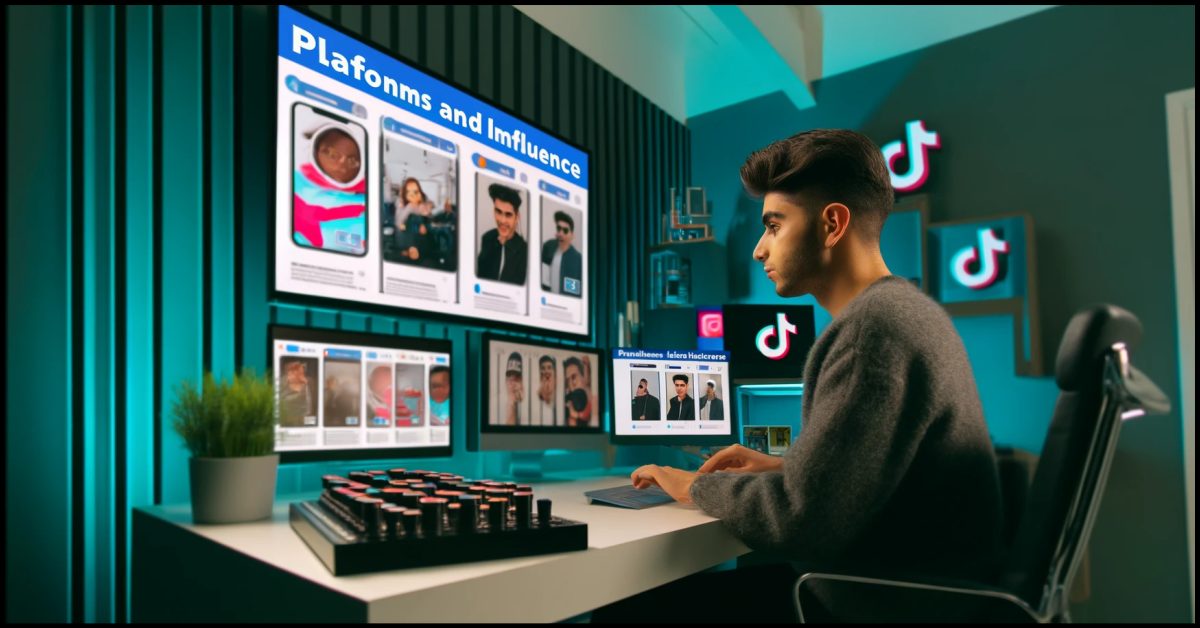In today’s digital realm, “Metrics of Influence: Followers, Fame, and Influencer Success” examines how follower counts, engagement rates and platform algorithms shape influencers’ careers. This article analyzes how influencers use social media marketing on platforms like Instagram, TikTok, and YouTube to expand their reach and monetize. It explores influencer marketing, digital marketing, and content marketing, highlighting the thresholds for fame and income. With insights into effective marketing strategies and the economic impact of digital marketing jobs, this article is essential for online marketers aiming to maximize SEO and lead generation through an influential social media presence.
By Samareh Ghaem Maghami, Associate Technical and Interior Designer at Cademix Institute of Technology

Introduction
In the digital age, the term “influencer” has become synonymous with a new form of celebrity, powered by social media platforms and capable of reaching millions with a single post. “Metrics of Influence: Followers, Fame, and the Making of an Influencer” explores the intricate dynamics that define what it means to be an influencer in today’s digital landscape. From Instagram to TikTok, each platform offers unique opportunities and challenges that shape how influencers grow their followings and engage with their audiences.
Evolving Landscape of Influencer Marketing
In this article, we delve into the core metrics that gauge an influencer’s impact—chiefly, their follower count. However, we go beyond mere numbers to consider the importance of engagement rates, content quality, and the strategic use of digital marketing techniques. By understanding these metrics, aspiring influencers and marketing professionals can better navigate the complex interplay of factors that can turn an ordinary social media user into a powerful online presence.
metrics of influence in digital marketing
With a focus on how follower metrics influence marketability and earning potential, this article integrates essential SEO-rich keywords such as influencer marketing, digital marketing, and social media marketing. It aims to provide insights not only for those looking to become influencers but also for businesses aiming to enhance their online marketing strategies through influencer collaborations. As the digital landscape continues to evolve, so too does the blueprint for becoming a successful influencer, making it imperative to stay informed about the latest trends and methodologies in digital marketing.

Defining an Influencer
An influencer is typically understood as a person who has the power to affect the purchasing decisions of others because of their authority, knowledge, position, or relationship with their audience. In the context of social media, influencers are individuals who have built a reputation for their expertise and authenticity in a specific niche. This reputation enables them to engage with a large audience and exert influence through various forms of content like posts, blogs, videos, and direct interactions.
Categories of Influencers Based on Follower Count
Influencers can be categorized into four primary types based on their follower counts, each serving unique roles within the marketing ecosystem:
- Nano-Influencers: Typically have followers ranging from 1,000 to 10,000. They are known for their high engagement rates and niche audiences, making them ideal for targeted, community-focused campaigns.
- Micro-Influencers: Possessing between 10,000 and 100,000 followers, these influencers strike a balance between substantial reach and maintaining a personal connection with their audience, often yielding higher trust levels.
- Macro-Influencers: With followers ranging from 100,000 to 1 million, macro influencers offer a broader reach and are often considered mini-celebrities, which can be beneficial for brand awareness campaigns.
- Mega-Influencers: They exceed 1 million followers and are typically mainstream celebrities or internet sensations. Their massive reach is ideal for large-scale exposure, although it may come with lower engagement rates compared to smaller-scale influencers.
Importance of Engagement Beyond Follower Count
While the number of followers is the most visible metric, engagement rate—which measures the interaction between followers and the influencer’s content through likes, comments, shares, and other reactions is equally critical. Engagement rates often provide deeper insights into how meaningful and influential the relationship between the influencer and their followers truly is. High engagement rates can indicate a loyal and active following, which is more likely to be influenced by the influencer’s recommendations and actions.

Platforms and Influence
The digital realm offers a plethora of platforms each tailor-made for specific content types and engagement styles. These platforms are not just social media sites; they are powerful tools in the influencer marketing toolkit, each having distinct algorithms and user demographics that influence the effectiveness of marketing strategies.
Major Platforms for Influencers
- Instagram: A visually driven platform ideal for brand partnerships, Instagram excels in showcasing lifestyle, beauty, fashion, and food content. With features like Stories, Reels, and IGTV, influencers have various tools to engage creatively with their audience. Instagram’s algorithm favors high-quality visuals and consistent engagement, making it essential for influencers to maintain regular interaction through comments and likes to boost their visibility.
- TikTok: Known for its viral potential and younger demographic, TikTok serves as a launchpad for trends and has a unique algorithm that favors novel and entertaining content over follower count. This platform is particularly beneficial for influencers looking to quickly gain traction through short, catchy videos that may capture the zeitgeist of current trends.
- YouTube: As the premier platform for long-form video content, YouTube is critical for influencers who specialize in detailed storytelling, tutorials, and reviews. YouTube’s search-driven algorithm benefits from optimized video titles, descriptions, and tags, making it an excellent venue for educational and in-depth content, which can also be effectively monetized through ads and sponsorships.
Platform-Specific Features Benefiting Influencers
Each platform offers unique features that can be strategically leveraged by influencers to enhance their reach and engagement:
- Instagram offers Shop features directly through posts, appealing directly to e-commerce links and sponsored content.
- TikTok’s For You page algorithm provides unexpected exposure to new audiences, regardless of the existing follower count.
- YouTube rewards longer watch times with better visibility, incentivizing the creation of compelling content that viewers watch through to the end.
Followers – The Primary Metric of Influence
The number of followers an influencer has is often seen as a direct measure of their influence and potential reach. This metric is crucial not only for influencers themselves but also for brands and digital marketing agencies looking to partner for impactful online marketing campaigns.
Impact of Follower Count on Reach and Credibility
The follower count serves as a primary indicator of an influencer’s reach, providing a baseline from which to measure their potential impact on audiences. Brands often consider influencers with higher follower counts as more attractive partners because they can reach larger audiences with a single post. However, credibility is also a significant factor influenced by follower metrics. Influencers who have built their following organically tend to have higher credibility among their audience, which can lead to more effective influencer marketing campaigns.
Engagement Rate and Its Importance
The engagement rate complements the follower count by showing how actively involved the followers are with the influencer’s content. It is calculated based on interactions such as likes, comments, shares, and views, divided by the number of followers, and then multiplied by 100 to get a percentage. A high engagement rate indicates that the influencer’s content resonates well with their audience, which is crucial for campaigns that rely on audience interaction, such as “lead generation” and “content marketing.” This metric is particularly important in “SEO marketing,” where the aim is to not only reach but actively engage an audience to build lasting relationships.
The Role of Keywords in Enhancing Follower Metrics
Incorporating relevant keywords like “network marketing,” “digital marketing,” and “social media marketing” into content can significantly enhance an influencer’s visibility and follower growth. Keywords help in optimizing content for search algorithms on platforms like Instagram and YouTube, making the content more discoverable and increasing the chances of gaining new followers. Additionally, using keywords effectively can help in targeting specific audiences, which is beneficial for both “affiliate marketing” and “email marketing” strategies.
Strategic Use of Advertising to Boost Follower Count
“Facebook advertising” and other “advertising agency” services offer targeted advertising solutions that can help influencers increase their follower counts quickly. These services use sophisticated algorithms to place ads in front of users who are most likely to engage with the influencer’s content, based on their online behavior and preferences. This method is an integral part of a comprehensive “marketing strategy,” especially when combined with “online marketing” and “digital marketing agency” tactics to maximize reach and impact.
In summary, while follower count remains a critical metric in measuring an influencer’s potential reach and influence, it is the engagement rate that often determines the actual effectiveness of their influence. For influencers and marketers alike, understanding how to strategically use keywords and advertising to enhance these metrics is key to successful influencer marketing. As the digital landscape evolves, so too must the strategies employed to navigate it, ensuring that both influencers and brands can achieve their marketing objectives effectively.
TikTok – A Case Study in Influencer Metrics
TikTok has emerged as a revolutionary platform in the social media marketing landscape, particularly for influencers aiming to capture the attention of younger demographics. This section delves into TikTok’s unique algorithm and its implications for influencer success, emphasizing the importance of understanding platform-specific dynamics in digital marketing.
Understanding TikTok’s Algorithm
TikTok’s algorithm is distinct in its ability to promote content based on user engagement rather than just follower count. This democratizes content visibility, allowing even influencers with smaller follower bases to achieve significant reach if their content resonates well with audiences. The algorithm prioritizes user interaction—likes, comments, shares, and watch time—which encourages influencers to create highly engaging and creative content. This feature aligns well with strategies in “content marketing” and “engagement marketing,” focusing on virality and interaction rather than traditional metrics.
Follower Thresholds for Influencers on TikTok
While there is no set number of followers required to be deemed an influencer on TikTok, reaching certain follower milestones can unlock additional features such as live streaming and the ability to participate in more lucrative brand partnerships. These thresholds act as goals for aspiring influencers and are critical for strategies involving “influencer marketing” and “digital marketing.” As part of a comprehensive “online marketing” strategy, understanding these thresholds can help influencers and marketing agencies maximize the impact of their campaigns.
Keywords and Content Optimization on TikTok
Effective use of keywords like “digital marketing,” “SEO marketing,” and “social media marketing” within TikTok content can significantly enhance discoverability and follower engagement. Hashtags, a form of keyword, are especially powerful on TikTok and can be strategically used to tap into trends, reach target audiences, and increase visibility. This approach is crucial for “lead generation” and “network marketing,” where the goal is to convert viewers into followers and customers.
Leveraging TikTok for Influencer Marketing Campaigns
TikTok offers immense potential for “affiliate marketing” and “advertising agency” collaborations, with its format ideally suited for spontaneous and authentic content that resonates with a younger audience. The platform’s advertising solutions, such as branded hashtags and in-feed ads, provide additional avenues for influencers to monetize their presence and for brands to amplify their reach through these influential partnerships.
In conclusion, TikTok exemplifies the shift towards more dynamic and interactive forms of social media that prioritize user engagement over static metrics like follower counts. For influencers and digital marketers, mastering TikTok’s algorithm and leveraging the right marketing keywords can lead to unprecedented engagement levels, making it a cornerstone platform in modern “influencer marketing” strategies. As the digital landscape continues to evolve, staying ahead in platforms like TikTok is essential for maintaining relevance and effectiveness in the competitive field of digital marketing.

Monetization of Influence
The ability to monetize one’s influence on social media platforms, particularly Instagram, is a critical aspect of a successful influencer career. This section explores the essential thresholds of followers needed to start earning and the varying payment structures, focusing on Instagram as a prime example for influencer monetization.
Thresholds for Earning on Instagram
On Instagram, becoming monetizable typically begins once influencers hit the micro-influencer level, with at least 10,000 followers. This milestone allows access to Instagram’s “Swipe Up” feature in Stories, facilitating direct links to external sites, which is highly beneficial for “affiliate marketing” and “lead generation.” As influencers grow to macro and mega levels, their earning potential increases significantly, with the ability to command substantial fees for sponsored posts, brand deals, and collaborations.
Payment Structures for Influencers
Payment for influencer services on Instagram can vary widely, depending on factors such as niche, engagement rate, and the specific demands of the campaign. Common structures include:
- Pay Per Post: A fixed fee for each sponsored post.
- Commission: Earnings based on sales or leads generated from influencer promotions, a key component of “affiliate marketing.”
- Free Products: Compensation through products or services instead of monetary payment, often utilized by brands as part of a broader “content marketing” strategy.
Utilizing SEO and Keywords for Enhanced Monetization
Effective use of SEO techniques and strategic keyword incorporation, such as “digital marketing,” “social media marketing,” and “online marketing,” can significantly boost an influencer’s visibility and attractiveness to potential brand partners. By optimizing content and profiles for search, influencers can attract more targeted partnership opportunities, which often leads to higher compensation rates and better-aligned collaborations.
Advertising and Sponsored Content
“Facebook advertising” and other platform-specific ads offer influencers additional revenue streams. By creating sponsored content that aligns with their authentic style and audience interests, influencers can maintain audience trust while effectively monetizing their reach. These practices are supported by “advertising agencies” that specialize in matching brands with the right influencers, ensuring that marketing messages are seamlessly integrated into the influencer’s content stream.
The Role of Digital Marketing Agencies
“Digital marketing agencies” play a crucial role in scaling an influencer’s monetization strategy. They provide expertise in “network marketing,” “email marketing,” and “SEO marketing,” helping influencers to professionalize their approach and maximize earnings. Agencies also assist with negotiating contracts and ensuring that engagement metrics are met, safeguarding the influencer’s interests and campaign success.
In conclusion, monetizing influence on platforms like Instagram involves more than just accumulating followers. It requires a strategic approach to “online marketing” and “influencer marketing,” utilizing comprehensive “digital marketing” strategies to attract and maintain profitable partnerships. As the landscape of social media continues to evolve, influencers must adapt their monetization tactics to stay competitive and financially successful in the dynamic world of digital marketing.

Sustainability of Influence
Maintaining and growing influence in the ever-evolving world of social media is a challenge that requires strategic foresight and adaptability. This section discusses how influencers can sustain their relevance and effectiveness over time, highlighting the importance of evolving marketing strategies and continuous engagement with emerging trends.
Longevity in the Influencer Space
The key to sustained success as an influencer involves more than just maintaining a high follower count; it necessitates ongoing engagement and renewal of content strategies to keep audiences interested and engaged. Influencers must stay abreast of changes in platform algorithms and audience preferences, which are critical for “social media marketing” and “digital marketing” success.
Developing a Diverse Content Strategy
Diversification of content is essential for influencers seeking long-term relevance. This includes varying the type of content (videos, blogs, live streams), the platforms used (Instagram, TikTok, YouTube), and the subjects covered. Adapting “content marketing” strategies to include a range of topics and formats helps capture wider audiences and reduces the risk of follower attrition due to content fatigue.
Leveraging SEO and Keyword Optimization
Effective use of “SEO marketing” techniques is crucial for sustaining an influencer’s visibility online. Keywords such as “online marketing,” “email marketing,” and “lead generation” should be strategically incorporated into content to boost organic search rankings and visibility across different platforms. This not only attracts new followers but also keeps existing audiences engaged by ensuring content remains discoverable and relevant.
Continuous Learning and Adaptation
Influencers must commit to continuous learning about the latest “digital marketing” trends, platform updates, and audience analysis tools. This knowledge enables them to adapt their strategies effectively and anticipate shifts in the digital landscape, ensuring their influence remains strong. Workshops, webinars, and collaboration with “digital marketing agencies” can provide insights and skills necessary for this ongoing development.
Networking and Collaborations
Building and maintaining a network of fellow influencers, brands, and “marketing agencies” can significantly enhance an influencer’s sustainability. Collaborations allow influencers to reach new audiences, share resources, and diversify their content, which can lead to new opportunities and increased resilience against market changes.
Sustainability in the influencer market requires a dynamic approach to “network marketing” and “influencer marketing,” where adaptability and continuous improvement are key. By engaging with current trends, utilizing advanced “SEO marketing” strategies, and fostering strong industry relationships, influencers can ensure their continued relevance and success in the competitive digital arena. As the influencer landscape evolves, so too must the strategies they employ, turning adaptability and foresight into essential components of their long-term marketing and engagement plans.
Conclusion
In the digital sphere, where the landscape of influence is perpetually evolving, understanding the dynamics of follower metrics and platform-specific strategies is crucial for anyone aiming to forge a successful path as an influencer. “Metrics of Influence: Followers, Fame, and the Making of an Influencer” has traversed the complexities of what it takes to not just grow but also sustain and monetize influence across various social media platforms.
This article has outlined essential insights into the metrics of followers, engagement rates, and platform algorithms, highlighting how each element contributes to the crafting of a powerful influencer. From the nuances of TikTok’s engagement-driven algorithm to the strategic monetization opportunities on Instagram, we’ve delved into how influencers can optimize their content and engagement strategies to enhance their digital footprint and economic viability.
Looking forward, the realm of influencer marketing is poised for continued growth and transformation. Influencers and digital marketers must stay ahead of trends, constantly evolving their strategies to include cutting-edge “SEO marketing,” “content marketing,” and “social media marketing” tactics. The integration of emerging technologies and analytics tools will further refine how influence is measured and monetized, making adaptability and continuous learning paramount for ongoing success.
For aspiring influencers, digital marketers, and brands, the journey into influencer marketing is one of perpetual discovery and adaptation. Engage with ongoing education in “digital marketing” and “online marketing” to understand and leverage the evolving tools and strategies that drive influence. Explore collaborations with “digital marketing agencies” and “advertising agencies” to expand your reach and refine your marketing strategies, ensuring that your approach to influencer marketing is as dynamic and impactful as the digital landscape itself.
In conclusion, whether you are an emerging influencer or a seasoned marketing strategist, the insights provided here should serve as a foundation for building and sustaining influence in the digital age. By leveraging key marketing strategies and embracing the continuous evolution of digital platforms, you can maximize the impact and longevity of your influence, ensuring that your voice not only reaches but resonates with your intended audience in meaningful ways.

About the Author
Samareh Ghaem Maghami, an experienced professional in painting, interior decoration, and event management, is currently pursuing a Master’s in eco-design at FH Wiener Neustadt in Austria. With a focus on sustainable practices and integrating nature into design, she brings a wealth of creative and organizational skills to her projects. Samareh’s expertise and passion for nature make her an invaluable asset in eco-centric and creative endeavors. Connect with her on LinkedIn for collaboration opportunities or to learn more about her work.
She is also an Associate Technical and Interior Designer at Cademix Institute of Technology and a member of the Cademix Career Autopilot Program.
Please feel free to contact her under:
E-mail: sam.gh.maghami@gmail.com
E-mail: samareh.ghaem-maghami@cademix.org
LinkedIn: https://www.linkedin.com/in/samareh-ghaem-maghami
Xing: https://www.xing.com/profile/Samareh_GhaemMaghami

